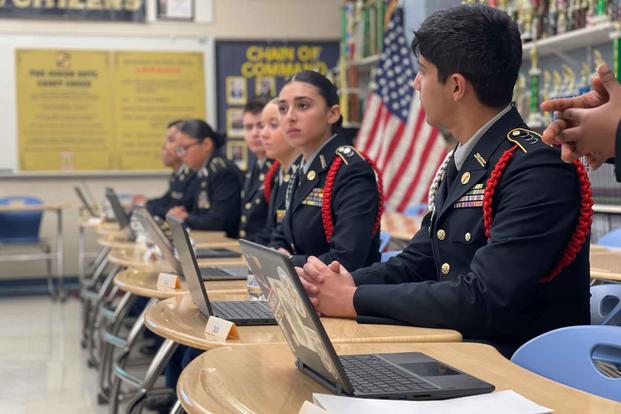Rhea-Lee Thompson emigrated from Jamaica to the United States in 2019. She never thought about joining her adopted country's military but became enamored with the idea of service once she saw her school's Junior Reserve Officers' Training Corps, or JROTC.
"JROTC has given me a home away from home and [helped me] grow as a person," Thompson, 16, told Military.com in a classroom that serves as home base for the military's footprint at Alexandria City High School.
The room, in a school nestled in a wealthy northern Virginia suburb just outside of Washington, D.C., is filled with trophies and other accolades from generations of students who were in the program. It's one of the only public schools in an area littered with exclusive private schools.
Read Next: Second Fort Jackson Drill Sergeant Found Dead on Base This Month
Thompson, who sees the military as a pathway to citizenship, has a decorated academic resume for a teenager. She's her JROTC class leader, or "battalion commander," and her GPA is over 4.0. She hopes to move onto ROTC in college and become a medical officer.
It's students like her whom the military hopes to convert from promising applicants to active-duty service members. JROTC is a program funded by the Pentagon designed to teach basic civics and leadership skills -- all while subtly pitching military service to those students through trips to military bases, doing military-style physical challenges like obstacle courses, and having them occasionally wear uniforms. JROTC units are commonplace in parades and other military ceremonies to give those students a taste of the culture.
The Pentagon has generally struggled to fill the ranks in most of its services, a slump that is a complicated amalgamation of issues. Many experts and service planners point to a lack of cultural touch points: Young Americans simply aren't exposed to the culture. There is no "Black Hawk Down" in movie theaters courting the would-be door kicker, the most popular video games have become increasingly fantastical and detached from the military realism some titles sought in the mid-2000s, and recruiters are still struggling to regain a foothold in high schools since the COVID-19 pandemic forced everybody to stay home.
But JROTC, a program that has existed since World War I, offers an increasingly rare means of connecting students who will soon be old enough to join the military with those in uniform. Army planners are quick to say JROTC isn't a recruiting tool, but roughly one-quarter of students in the program end up enlisting or commissioning. Though it's unclear how many of those students would have otherwise joined the military, as other cultural touchstones evaporate, the services have planted a flag in schools across the country and plan to grow their footprints.
"By definition, we are not a recruiting tool," Col. Ken Jones, the director for Army JROTC, told Military.com. "We're charged with introducing kids to opportunities. We want them to know what's available to them, and that includes military opportunities. … We're that connective tissue between the community and their Army."
The program has been rocked by controversy since the Vietnam War over concerns of militarizing America's youth.
Concerns over course instructors sexually harassing or assaulting teenage cadets have also been persistent. In recent months, the Army has established new guidance aimed at preventing gender-based discrimination and enforcing laws against sexual violence by instructors. A New York Times investigation found that thousands of teens were forced into the program by their schools, a move that is discouraged but not outright forbidden by the military services. Congress just recently included a provision in the must-pass National Defense Authorization Act, or NDAA, banning forced enrollment.
That bill, which is set to be signed into law by President Joe Biden, also directs the Pentagon to submit an annual report of sexual misconduct in JROTC, including details on the outcomes of investigations. Officials will also be required to notify the secretary of their service within two days of any allegations of sexual misconduct involving an instructor.
There are now 1,734 Army JROTC programs in high schools, with some 275,000 cadets. The program has steadily grown each year, with even more expansion in the coming years being mulled by Army planners. Some 280 schools are on a wait-list for their own JROTC programs to be established. With a relatively modest $200 million budget, it costs the Army only about $800 per cadet each year, sharing a lot of the costs with the school.
Students who finish the program, in some cases, may earn scholarships or some advanced placement in ROTC in college. Cadets who complete three years of JROTC can enlist in the Army as a private first class, though the Army offers numerous other fast tracks to that rank. The active-duty force at large doesn't generally hold JROTC experience as a major achievement, and those who complete the program are sometimes viewed as having missed out on chances of a more rebellious youth.
But that doesn't mean it isn't valuable to the military services, with the chance for more if the reputation could be buttressed.
"It's certainly missing an X-factor, something that makes it cool," one infantry Army lieutenant told Military.com on the condition of anonymity because they were not authorized to speak to the media on the topic. "The footprint is there, there's a lot of value in that, but I think there's an opportunity for the Army to double down."
Editor’s Note: This story has been updated to include details on potential promotion fast tracking that is available to ROTC cadets.
Related: Senators Seeks More Safeguards in JROTC Program After Reports of Sexual Abuse












